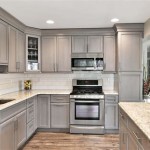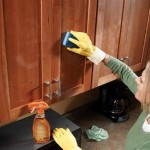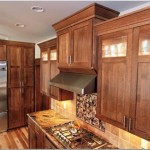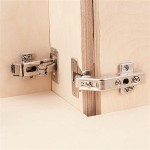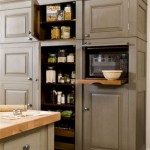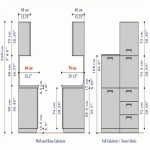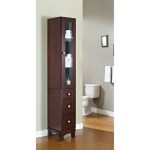Best Way to Get Grease and Grime Off Kitchen Cabinets
Kitchen cabinets, often the unsung heroes of the culinary space, relentlessly endure a barrage of airborne grease, splattered sauces, and accumulated grime. Over time, this accumulation can compromise the aesthetic appeal of the kitchen and harbor bacteria. Maintaining clean cabinets requires a strategic approach tailored to the cabinet material and the severity of the buildup. This article explores effective methods and cleaning solutions to eradicate grease and grime, restoring cabinets to their original luster.
Addressing the issue of greasy cabinets frequently involves a combination of appropriate cleaning agents, tools, and techniques. Understanding the fundamental properties of grease and the characteristics of different cabinet finishes is paramount for selecting the optimal cleaning strategy. Abrasive cleaners, for instance, can permanently damage certain types of finishes, while gentle degreasers might be insufficient for heavily soiled surfaces.
Identifying Cabinet Material and Finish
Prior to initiating any cleaning process, accurately identifying the cabinet material and finish is crucial. Common cabinet materials include solid wood (oak, maple, cherry), laminate, veneer, and painted surfaces. Finishes can range from glossy and semi-gloss paints to matte finishes, varnishes, and polyurethane coatings. Each material and finish combination reacts differently to various cleaning agents. Failure to consider these factors could lead to irreversible damage, discoloration, or etching.
Wood cabinets, for example, are susceptible to water damage and require cleaning solutions that are not overly saturated. Laminate cabinets are generally more resilient but can still be damaged by abrasive cleaners that scratch the surface. Painted cabinets, depending on the type of paint used, may be susceptible to chipping or peeling if exposed to harsh chemicals or excessive scrubbing.
A simple test in an inconspicuous area of the cabinet can help determine the material's reaction to a particular cleaning solution. Apply a small amount of the chosen cleaner to a hidden spot, such as the inside of a cabinet door, and observe for any adverse effects after a short period. This precautionary step can prevent widespread damage to the entire cabinetry system.
Effective Cleaning Solutions and Their Application
A multitude of cleaning solutions can effectively remove grease and grime from kitchen cabinets. The choice of solution should be based on the severity of the buildup and the type of cabinet material and finish. Gentle, homemade solutions are often the safest starting point, while more potent commercial degreasers may be necessary for stubborn stains.
A widely recommended solution involves a mixture of warm water and dish soap. The mild surfactants in dish soap effectively break down grease molecules, allowing them to be easily wiped away. This method is suitable for light to moderate grease buildup on most cabinet surfaces. Simply mix a few drops of dish soap into a bowl of warm water, saturate a soft cloth with the solution, and gently wipe down the cabinets. Follow up with a clean, damp cloth to remove any soap residue, and then dry the cabinets thoroughly.
For more persistent grease stains, a baking soda paste can be employed. Baking soda is a mild abrasive that can help lift stubborn grease without causing significant damage to most cabinet finishes. Mix baking soda with a small amount of water to form a thick paste. Apply the paste to the affected areas, allow it to sit for a few minutes, and then gently scrub with a soft cloth or sponge. Rinse thoroughly with water and dry completely.
Vinegar, a natural degreaser, can also be used to clean greasy cabinets. Mix equal parts of white vinegar and warm water in a spray bottle. Spray the solution onto the cabinets and let it sit for a few minutes to dissolve the grease. Wipe down with a clean, damp cloth and dry thoroughly. Vinegar has a strong odor, so ensure the kitchen is well-ventilated during and after cleaning.
Commercial degreasers are available for heavy-duty cleaning tasks. These products often contain stronger chemicals that effectively cut through grease and grime. However, it is imperative to carefully read and follow the manufacturer's instructions, as some degreasers can damage certain cabinet finishes. Always test the product in an inconspicuous area before applying it to the entire surface. Wear gloves and eye protection when using commercial degreasers to prevent skin and eye irritation.
Step-by-Step Cleaning Process
A systematic approach to cleaning kitchen cabinets ensures thoroughness and efficiency. The following steps outline a comprehensive cleaning process that can be adapted to various cabinet types and degrees of soiling.
1.
Preparation:
Begin by removing all items from the countertops and clearing the area around the cabinets. This provides ample space to maneuver and prevents accidental spills or damage to nearby objects. Protect the floor beneath the cabinets with a drop cloth or towels to catch any drips or splatters.2.
Dusting:
Use a dry microfiber cloth or a vacuum cleaner with a brush attachment to remove loose dust and debris from the cabinets. This step is crucial as it prevents the dust from mixing with the cleaning solution and creating a muddy mess.3.
Applying Cleaning Solution:
Based on the chosen cleaning solution, apply it to the cabinets using a soft cloth or sponge. Avoid using abrasive scrub brushes or steel wool, as they can scratch the surface. For spray solutions, spray directly onto the cloth rather than the cabinet to prevent oversaturation and potential water damage.4.
Scrubbing:
Gently scrub the cabinets to loosen the grease and grime. Pay particular attention to areas around the stove and sink, as these are typically the most heavily soiled. Use a circular motion to effectively lift the dirt.5.
Rinsing:
Once the cabinets have been thoroughly scrubbed, rinse them with a clean, damp cloth. This removes any residual cleaning solution and prevents streaking. Change the water frequently to ensure a clean rinse.6.
Drying:
Dry the cabinets thoroughly with a clean, dry cloth. This prevents water spots and mildew growth. Pay attention to edges and corners, as these areas are prone to trapping moisture.7.
Polishing (Optional):
For wood cabinets, a furniture polish can be applied to enhance their shine and protect the finish. Follow the manufacturer's instructions for the specific polish being used.Preventive Measures and Maintenance
Regular maintenance is key to preventing the excessive buildup of grease and grime on kitchen cabinets. Implementing a proactive cleaning routine can significantly reduce the need for intensive cleaning sessions and prolong the lifespan of the cabinetry.
Wiping down the cabinets regularly, ideally once a week, can prevent grease and grime from accumulating. Use a damp cloth with a mild dish soap solution to remove any fresh splatters or spills. This simple task takes only a few minutes and can make a significant difference in the overall cleanliness of the kitchen.
Proper ventilation is essential for minimizing grease buildup. Use the range hood while cooking to effectively remove airborne grease particles. Ensure the range hood filter is clean and functioning properly. Regularly clean or replace the filter to maintain optimal performance.
Avoid placing appliances that generate heat or steam directly beneath cabinets. The heat and steam can damage the cabinet finish and contribute to grease buildup. Use heat shields or reposition appliances to minimize the impact on the cabinetry.
Immediately address any spills or splatters on the cabinets. The longer a spill sits, the harder it becomes to remove. Wipe up spills with a damp cloth as soon as they occur to prevent staining and grease buildup.
Applying a protective coating to the cabinets can also help to prevent grease and grime from adhering to the surface. Wax or polyurethane coatings can create a barrier that makes it easier to clean the cabinets and protects the finish from damage. Consult with a professional to determine the best protective coating for the specific cabinet material and finish.
By consistently implementing these preventive measures, homeowners can maintain clean and attractive kitchen cabinets, extending their lifespan and enhancing the overall aesthetic appeal of the kitchen space. Reduced build-up also means less harsh chemicals and potentially less time cleaning.

Get Grease Off Kitchen Cabinets Easy And Naturally

How To Clean Grimy Kitchen Cabinets With 2 Ingredients

How To Clean Kitchen Cabinets Everyday Skate

We Tried 5 Methods To Clean Greasy Wood Cabinets And The Winner Is Ridiculously Effective Kitchn Cleaning Kitchen

How To Clean Sticky Grease Off Kitchen Cabinets Ovenclean

3 Ways To Clean Greasy Kitchen Cabinets Wikihow Life

Best Ways To Clean Grease Stains Off Kitchen Cabinets

Get Grease Off Kitchen Cabinets Easy And Naturally

How To Remove Grease From Kitchen Cabinets 3 Methods Bob Vila

How To Clean Sticky Grease Off Kitchen Cabinets
Related Posts

